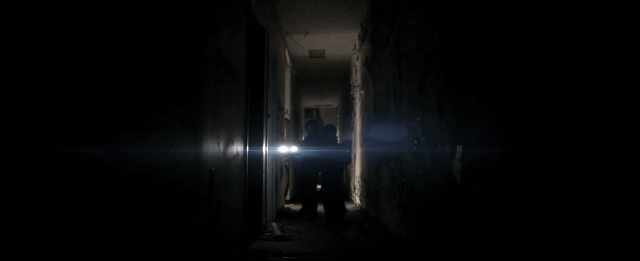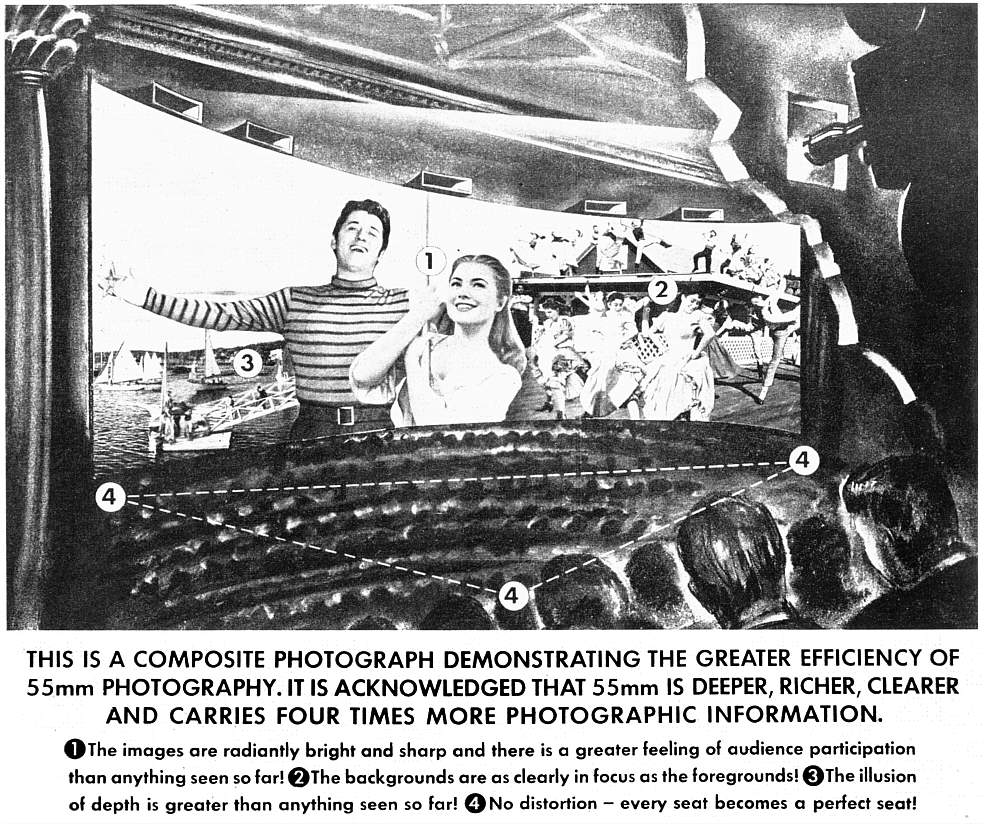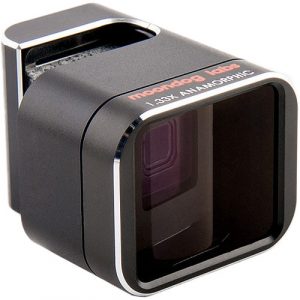Best Anamorphic Lens for your Phone
There are now hundreds of different lenses which can be added to your smartphone. They’re called conversion lenses because they convert (rather than replace) the existing lens. There are fisheye, macro, wide angle and telephoto lenses.
One of the most popular conversion lenses for smartphone filmmakers is the anamorphic lens. This is because it lends a certain cinematic quality to your videos other lenses cannot reach. For example, anamorphic lenses can create those long, thin lens flares from our favourite sci-fi shows and movies.
Below is a clip from one of MoMo’s Official Selections: Robot Attack, shot on an iPhone using a Moondog Labs anamorphic lens adapter.

But it’s not just about lens flares. The anamorphic lens gives you a true cinematic widescreen look. Of course you can simply crop the frame to create a widescreen look, but you’ll lose image resolution.
What is an anamorphic lens?
Anamorphics were first used in photography during World War 1, then later in a cinematic context in 1927.
An anamorphic lens series called CinemaScope was used mostly from the mid 1950s to mid 1960s. This was driven by the desire to create epic-looking, widescreen cinema experiences to put 4:3 ratio TV screens back in their place.
Whereas Cinerama and stereoscopic 3D died almost as soon as they were initiated, 20th Century Fox’s cheaper and more convenient CinemaScope used a simple anamorphic lens to create a widescreen effect.

In the image above, notice the curved screen to give the audience a greater feeling of being immersed in the movie.
How does an anamorphic lens work?
An anamorphic is a wide lens, but it’s different to regular wide lenses. Whereas a wide lens simply increases the field of view all around, the anamorphic only widens the field of view sideways.
This extra view is then squeezed into a 16×9 frame. When using an anamorphic lens therefore, you need to “de-squeeze” the squeezed image.
An app like FiLMiC Pro will de-squeeze the anamorphic image “in camera” so you can see what you are getting as you’re filming. Otherwise, you will need to de-squeeze using editing software. Either way, it’s something that is quite simple to do.
Learn how to De-Squeeze your anamorphic video.
Why should you buy one?
Anamorphic conversion lenses have been used by the top filmmakers shooting with iPhones. It was the invention of the Moondog Labs anamorphic lens which helped Sean Baker to decide to shoot Tangerine on iPhones. Steven Soderbergh used the same lens for his recent iPhone-shot Netflix feature High Flying Bird.
With new phones now coming with a variety of telephoto and ultrawide lenses inbuilt, there is perhaps less need now for many conversion lenses. However, no smartphone makers have yet included an anamorphic lens in one of their phones. And it seems unlikely they ever will, as this is such a speciality lens (but you never know…).
That means shooting with an anamorphic gives you a cinematic look you couldn’t otherwise achieve. The lens will set your videos apart from those using only inbuilt lenses. And it’s a look you can’t get in any other way.
Mounting your lens
When using any conversion lens for a smartphone, mounting the lens to your device is one of the major issues. There are a number of ways to mount a lens:
- clip
- brand case
- grip
The options available depend on your phone and the lens. I bought the 37mm version of the Moondog Labs lens, plus the Zecti grip, plus a 37mm clip. This gave me 2 mounting options. Neither are perfect: the clip covers FiLMiC’s exposure controls and the rig is too bulky for my gimbal.
So, you will have to look into mounting options for your phone and see what works best for you and your filming needs.
1. Moondog Labs
Back in 2014, Moondog Labs ran a successful Kickstarter campaign to raise money to produce their now near legendary 1.33x Anamorphic Adapter Lens for iPhone 5/5S. While many have tried to match the quality of the Moondog Labs lens since, I still believe it to be the best available.
Their team, including founders Scott Cahall and Julie Gerstenberger, has nearly 200 years of combined experience in optical design and engineering for photography, motion capture, projection, and display. The quality of the lens, to my eyes, is not quite matched by the competitors.
Last year, Moondog Labs added a bayonet mount version of their famous 1.33x anamorphic lens. This can be used with a number of bayonet mount cases, such as those made by Moment.
If you want a sample of what it looks like, you can watch the whole of Brian Vowles Robot Attack here:
Find their Anamorphic lens on Moondog Labs Official Website.
Other anamorphic smartphone lenses you might want to look at:
2. Moment
Moment have become the big hitters of smartphone lenses. Their marketing of their products is 2nd to none. They also make pretty good lenses.
They kicked off with a kickstarter in 2014. The campaign was a huge success, raising almost $0.5m from over 4000 backers. They first produced wide angle and telephoto conversion lenses. But not to be left out, they set up a Kickstarter for a Moment anamorphic in 2018.
The lens turned out to be very good indeed. It has a slightly different look to the Moondog Labs, but essentially does the same thing.
Find Moment Anamorphic on Amazon
Find Anamorphic Lens on Moment Official Website
3. Kapkur
When this lens first came out, I was impressed by the clarity the nice looking lens flares. This lens is very well built and very easy to use. This lens is also a bit lighter than the Moment lens. On the downside, the case is a little thin and doesn’t offer much protection to your phone.
Find Kapkur Anamorphic on Amazon
Here’s the lens tested on a Samsung Galaxy S10. You can see some vignetting in some shots due to him using the clip. A dedicated S10 case is not yet available.
4. Beastgrip
Beastgrip’s Anamorphic lens is listed at $175. They also make a 37mm mounting plate, which can be used with lenses with a 37mm thread (such as the Moondog Labs Anamorphic).
Read More: Beastgrip Lenses for Smartphone
5. Sandmarc
Sandmarc are well know iPhone conversion lens makers. They recently got in on the act and brought out an anamorphic. And it’s a good one!
Their lenses are only for iPhone. However I believe they also come with a clip which allows you to use the lens with other devices (unofficially).
Find the Anamorphic on Sandmarc’s Official Website
Budget Options
In recent times, a number of cheaper anamorphic conversion lenses have begun to appear on sites such as Amazon and AliExpress.
Ulanzi
Ulanzi have been making affordable gear for smartphones for a while. Now they have an anamorphic lens and it’s pretty good for the price.
Although I’ve seen this design before on other low cost lenses, I like the way the clip works. It seems like a simple solution is possible for lens mounting, without the rigs and cases the other brands want to sell you.
Find Ulanzi 1st Generation Anamorphic on Amazon
Find Ulanzi 3rd Generation Anamorphic on Amazon
Read Next: Moondog Labs, Moment, Ulanzi 1st & 3rd Gen Anamorphic compared.
Inverlee
Another one which was shared in our facebook group is on Amazon and called Inverlee. It looks basically the same as the Ulanzi (same clip). It also has one of the strangest names for a lens I’ve seen…
This is the description given to the lens on Amazon: “Help to Make More Perfect Photos and Videos, Better Record Life, Low-Cost Shooting of Miniature Movies (B)”
Is this a lens specifically for making B Movies? Or is there an A version of this title somewhere?
Smartphone Video – Beginner to Advanced
If you want to know more about smartphone filmmaking, my book Smartphone Videography – Beginners to Advanced is now available to download for members on Patreon. The book is 170 pages long and covers essential smartphone filmmaking topics:
Things like how to get the perfect exposure, when to use manual control, which codecs to use, HDR, how to use frame rates, lenses, shot types, stabilisation and much more. There’s also my Exploring the Film Look Guide as well as Smartphone Colour Grading.
Members can also access all 5 episodes of our smartphone shot Silent Eye series, with accompanying screenplays and making of podcasts. There’s other materials too and I will be adding more in the future.
If you want to join me there, follow this link.
Simon Horrocks
Simon Horrocks is a screenwriter & filmmaker. His debut feature THIRD CONTACT was shot on a consumer camcorder and premiered at the BFI IMAX in 2013. His shot-on-smartphones sci-fi series SILENT EYE featured on Amazon Prime. He now runs a popular Patreon page which offers online courses for beginners, customised tips and more: www.patreon.com/SilentEye




Hi Simon, I love your article. I am new with anamorphic lenses, I would like your recommendation on a affordable clip lens to achieve a movie feeling look. I use a view 20 Huawei.. Thank you